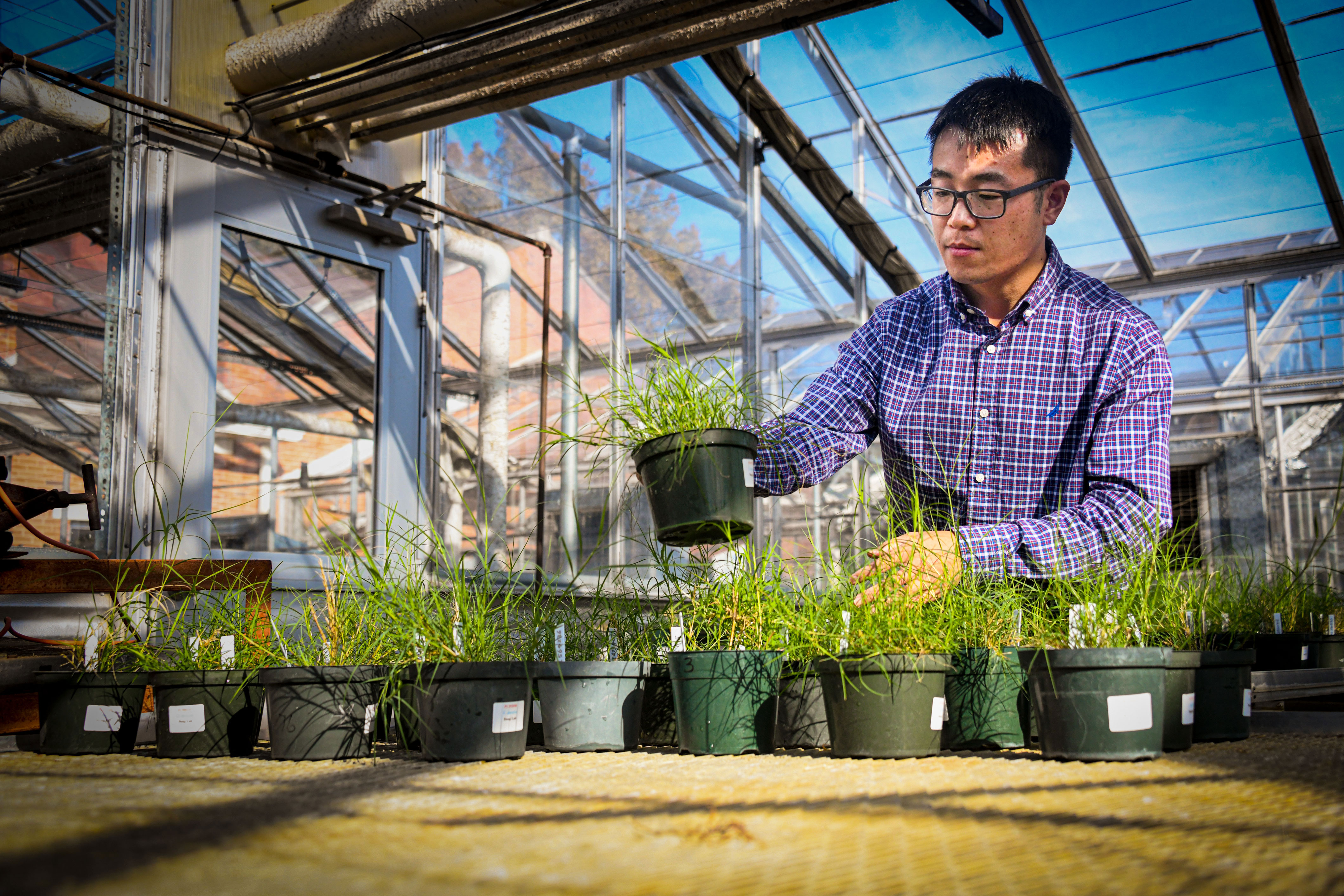News
The information presented on this page may be outdated. It may refer to situations which have changed or people who are no longer affiliated with the university. It is archived as part of Mississippi State University's history.
MSU releases new Bermuda grass turf for truer putting greens

Mississippi State Assistant Professor Hongxu Dong, a scientist in the Mississippi Agricultural and Forestry Experiment Station who specializes in turfgrass breeding and genetics, evaluates grasses in a university greenhouse. (Photo By: Dominique Belcher)
5/6/2022
By: Grace Jones
Scientists in the Mississippi Agricultural and Forestry Experiment Station have developed two new turfgrass cultivars as the first hybrid Bermuda grass cultivars unrelated to the commonly used "Tifgreen."
"The superior performance of these two grasses provides stakeholders with new options in the putting green market," said Assistant Professor Hongxu Dong, who specializes in turfgrass breeding and genetics. "These two grasses are adding novel genetic diversity to the Bermuda grass cultivars, especially to the ones used on putting greens."
He noted that "MSB-264" and "MSB-285" have a more upright leaf orientation than traditional Bermuda grass putting green cultivars. While these are visually similar, they have different genetic compositions. Both are propagated vegetatively and are sterile triploid genotypes, meaning that they do not produce seeds.
"This has the potential to allow truer putting and to hold golf shots better than existing ultra-dwarf Bermuda grass cultivars," Dong said.
Developed by MAFES scientists in MSU's Department of Plant and Soil Sciences, the cultivars have proven successful during their growing seasons.
"Both 'MSB-264' and 'MSB-285' exhibited superior turf quality, leaf texture, density, genetic color, fall and winter color retention, spring green-up speed and high percentages of living ground cover," Dong said.
"Compared to Tifgreen-derived cultivars, which are the mainstay of the warm-season golf course putting green market, 'MSB-264' and 'MSB-285' were bred from a much different genetic background. These variants are full siblings derived from a cross of two parents," he explained. In 2013, the National Turfgrass Evaluation Program began a five-year trial of warm-season putting green cultivars across locations in Arkansas, Arizona, California, Florida, Georgia, Indiana, Kentucky, Mississippi, Texas and Virginia. Those studied included the MAFES Bermuda grasses and commercial cultivars like "Sunday," "TifEagle," "Tifdwarf" and "Mini-Verde."
The breeding-to-commercialization process is long and arduous, taking between 10 to 12 years to develop a single cultivar. It begins with characterization of germplasm materials and hybridization between selected parents that demonstrate superior and unique characteristics.
"Because the process is so long and because you have to accumulate so much data to patent and market a grass, we have 110 to 120 grasses being evaluated for athletic fields, golf courses and home lawns," Dong said. "The breeding program is a numbers game. The more varieties you are testing, the better the chances of having some that are good enough to enter the trials and then go into production and commercialization."Recently retired MSU turfgrass breeder Wayne Philley led the MAFES development. Both grasses are available for licensing. To learn more about licensing, contact Jim Mitchell, licensing associate in MSU's Office of Technology Management, via email at jfm93@msstate.edu or call 662-325-8223.
For more on MSU?s Department of Plant and Soil Sciences, visit www.pss.msstate.edu. To learn more about MAFES, visit www.mafes.msstate.edu.
MSU is Mississippi's leading university, available online at www.msstate.edu.
View More News